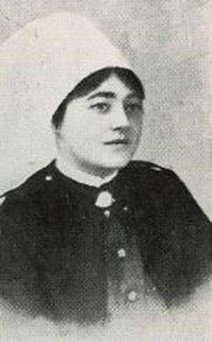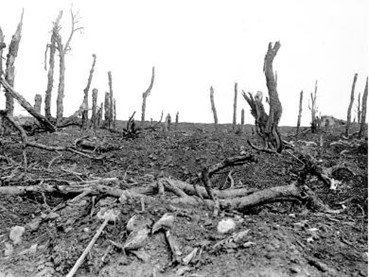Australia’s involvement in the First World War began when Britain and Germany went to war on 4 August 1914, and both Prime Minister Joseph Cook and Opposition Leader Andrew Fisher, who were in the midst of an election campaign, pledged full support for Britain. The outbreak of war was greeted in Australia, as in many other places, with great enthusiasm but, unlike the other countries engaged in WWI, conscription was not introduced and all Australians who fought in WW1 were volunteers. And yet, the First World War remains the costliest conflict for Australia in terms of deaths and casualties. From a population of fewer than five million, 416,809 enlisted, more than 60,000 were killed and 156,000 wounded, gassed, or taken prisoner.
The family
Christopher James Hough was born near Bunbury on 7 March 1862, and his future wife Isabella Ann McConnell was born in Victoria in 1865. They married in Victoria in 1885 but moved to Western Australia, living in and around Busselton. The couple had six children namely Mabel Luisa (1887-1932), Leonard Irwin (1889-1980), Christopher Leslie (1891-1916), Roderick Owen (1893-1961), Edith Evelyn (1894-1972) and Mena Hough (1896-1956). When the father Christopher died on 13 April 1914, they were living at 69 Colin Street, Perth, but it would appear the family moved at least twice after Christopher’s death before they settled at 11 Cantle St, Mt Lawley, around 1917. Mrs Hough remained living in Cantle St until after 1923.
The Hough Family saw three of their six children volunteer and serve in WWI but only two would return home. Two of the boys, Leonard and Christopher, enlisted in 1914 and 1915 respectively whilst their sister Edith served with the Australian Army Nursing Service from 1917. These are their stories.
Leonard Irwin Hough
Photo courtesy Virtual War Museum Australia
Gravestone of Christopher Hough
Photo courtesy Virtual War Museum Australia
Edith Hough
Photo courtesy Virtual War Museum Australia
Leonard Irwin Hough
Leonard Irwin Hough was born in Busselton 31 September 1889. Prior to enlistment, he was working on the railways as an Engine Fireman. He enlisted when 25-years-old on 5 October 1914 and went to the Blackboy Hill training camp at the foot of the Darling Ranges. He was 5ft 7in tall and weighed just under 60kg, and was accepted as fit for service despite having had his right big toe previously amputated.
HMHS St David c1914
Private Leonard Hough left Australia on HMAT A31 Ajana on 31 December 1914 bound for Egypt. He was transferred to the 13th Field Artillery Brigade as a driver on 9 April 1916. He embarked upon the Rhesus in Alexandria on 16 June 1916 and arrived in Marseille, France on 24 June 1916 but was frequently sick and hospitalised between September and November 1916 when he returned to England on the hospital ship HMHS St David with chronic rheumatism.
After 656 days of illness, he left for Australia on HMAT Runic via Devonport on 4 May 1917 as medically unfit with the added problem of his pre-war amputated toe and an old fracture in his thigh.
Upon his return to Perth, he lived at 11 Cantle Street and registered for home service. He was discharged from the AIF in September 1918. In 1919 he married Margaret May Bennett (1890-1965) and they moved out of Mt Lawley to Fremantle where Leonard worked as a storeman. Leonard enlisted for home service again at the outbreak of WWII. He died in Perth in 1980.
Christopher Leslie Hough
Christopher Leslie, born in 1891 in Busselton, was the second son in the Hough family. He enlisted on the 15 June 1915 when 24-years-old whilst he was living with his mother and working as a Commercial Traveller. At the time of enlistment, he was 5ft 7in tall, weighed 62.1kg and had blue eyes and light brown hair. He also went to the Blackboy Hill training camp. Christopher joined the 2nd Anzac Light Horse Regiment in November 1915 and travelled to Egypt.
Somme Valley near Pozieres, c1916
On arrival at the end of November, he was taken to the 19th British General Hospital in Alexandria with mumps, and in January 1916 he was transferred to a Convalescent Camp. At the end of January, he re-joined his unit and was sent to France on 22 March 1916 leaving Alexandria on SS Bohemian and arriving at Marseille 28 March 1916.
On the 18 August 1916 he was killed in action in the field around the village Pozières, France, in the Battle of the Somme. It has been stated that for several weeks Pozières became the focus of the Somme fighting and the worst place to be on earth. Of the 23,000 Australian casualties, 6,800 men were killed or died of wounds. Lance Corporal Christopher Hough is buried in the Rue-David Military Cemetery, Fleurbaix, Nord-Pas-de-Calais, France, and his gravestone bears the inscription “HATING WAR HE MADE THIS SACRIFICE”. His personal effects (disc, scissors, notebook, wallet, ring [broken], pipe, photos, letters) were sent to his mother on 24 July 1917.
No 1 Australian Auxiliary Hospital during WWI
Edith Evelyn Hough
Edith was the second daughter of Christopher James and Isabella Ann Hough and lived at 11 Cantle St, Mount Lawley. She had previously worked as a certified nurse. She joined the Australian Imperial Force (AIF), Australian Army Nursing Unit (AANS) when 23-years-old as a Staff Nurse on 16 November 1917. She was 5ft 5in tall, weighed 59kg and had blue eyes and brown hair. She embarked on HMAT SS Canberra at Fremantle on 24 November 1917 to work at No 14 Australian General Hospital at Abbassia on the outskirts of Cairo. During her time in Egypt, Evelyn was taken sick twice and admitted to the hospital annexe in Port Said both times. Following the end of hostilities, Edith embarked on HMS Kaisar-i-Hind (Hindi name meaning “Empress of India”) on 27 December 1918 bound for the UK. She disembarked at Southampton on 7 January 1919 and was assigned to the No 1 Australian Auxiliary Hospital at Harefield Park House on the western outskirts of Greater London near Watford.
Edith married Captain Otto Ludwig Vetter, an Australian serving with the Royal Air Force, at St Andrews Church, Marylebone, London on 16 January 1919. She resigned from the service because nurses had to be single or widowed to serve, and she returned to Perth, Australia, settling in South Perth. Her husband ran Vetter and Co, Automobile Engineers at 50-56 Murray St Perth. They had 2 children, a daughter and a son. Their son, Flight Sergeant John Irwin Vetter of No 42 Squadron, RAAF died as a POW in Java in February 1945. Otto died in 1968 and Edith in August 1972.






